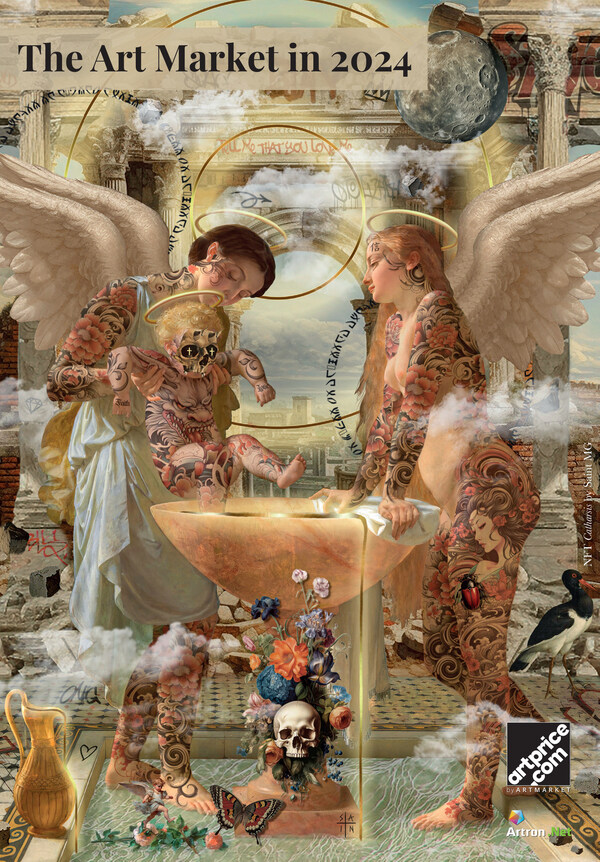

Front cover of Artprice’s 2024 Art Market Report
In this issue, The SeoulTech explores the scale of the global art market, focusing on the top three markets— the United States, China, and the United Kingdom— as well as South Korea, based on Artprice’s 2024 Global Art Market Report. By analyzing market trends and shifts, this article aims to shed light on the future outlook of the art market.
In 2024, the global art market entered a period of correction, adapting to shifting economic and political landscapes. The United States and the United Kingdom saw a contraction in their high-end art markets, while the mid-range art market remained resilient. China’s marketplace experienced a shift toward more selective collecting, with an increased focus on traditional and culturally significant works. Meanwhile, South Korea, despite a post-2021 downturn, continued to assert itself as a key player in the Asian art landscape.
The United States (US) remained the largest art market globally, leading with a total auction revenue of $3.8 billion, constituting approximately 32% of the total global market. New York served as the central hub of the US market, representing 89% of the country’s total auction sales. Major auction houses such as Christie’s and Sotheby’s played a dominant role in leading the high-end market.
However, 2024 marked a slowdown in the high-end art market, with a decline in the resale value of contemporary artworks. The rapid price increase seen during the post-pandemic art boom began to reverse. For instance, the auction sales of contemporary artist Loie Hollowell’s work plummeted from $10.8 million in 2022 to just $1.7 million in 2024. Similarly, Avery Singer’s works experienced a significant 72.7% drop in value, illustrating the overall contraction in the higher-end art sector.
This slowdown in the premium art market was compounded by political changes in the United States. In January 2025, President Donald Trump signed an executive order aimed at dismantling Diversity, Equity, and Inclusion (DEI) programs across federal institutions. As a direct result, the Art Museum of the Americas (AMA) was forced to cancel two major upcoming exhibitions: Before the Americas, which would have explored immigration and the African diaspora, and Nature’s Wild, a show focusing on Caribbean queer culture. The cancellation of these exhibitions came after the federal government withdrew funding, sparking concerns over increasing restrictions on artistic expression and the potential suppression of underrepresented voices in the art world.
The United Kingdom (UK) maintained its position as the third-largest global art market, achieving $1.4 billion in total auction sales in 2024. London, as the central hub of the UK art scene, accounted for 94% of the country’s auction sales. Both Christie’s and Sotheby’s remained influential, driving sales in the high-end sector.
However, as in the US, the UK’s premium art market showed signs of weakening. In contrast, the market for mid-tier and affordable artworks saw an increase in transaction volume. In London’s 2024 auctions, 103,000 pieces of art were sold, marking a 4% increase in volume from the previous year.
Despite this positive trend in mid-market sales, the UK art market continued to struggle with the lingering effects of Brexit. New tariffs on artworks moving between the UK and the European Union (EU)—ranging from 5% to 20%—complicated international art transactions. The added customs paperwork and administrative burdens further discouraged collectors, especially those from the EU, from purchasing art in the UK.
Adding to these challenges, the newly elected Labour government introduced tax reforms that are expected to increase financial pressure on local collectors. International mega-collectors, once attracted by the UK’s vibrant art market, have begun to turn their attention to more favorable regions, contributing to a stagnation in the UK’s art market.
China’s art market experienced a significant decline in 2024, with total auction revenues falling to $1.8 billion—down by approximately $3.1 billion from the previous year. This decline was largely attributed to the country’s economic slowdown and a shift in collector strategies.
Previously, there was a strong focus on high-end art investments, but in 2024, collectors adopted a more cautious approach, prioritizing works with cultural and historical importance over speculative investments. Traditional Chinese paintings and calligraphy saw a resurgence, with collectors placing more value on artworks with deep cultural roots.
At the same time, a few contemporary Chinese artists were able to achieve remarkable success. Zhang Enli’s Feast No. 4 and Qiu Xiaofei’s State-Run Goods set auction records, selling for $2.99 million each.
The South Korean art scene underwent a correction in 2024, with total auction sales falling to $70.6 million after peaking at $237 million in 2021. However, despite this decline, demand for leading Korean artists remained strong.
Kim Whan-Ki’s works remained highly sought after, with 32 of his pieces generating $13.9 million in auction sales. This placed him ahead of European modernist masters like Egon Schiele and Paul Cézanne in terms of total auction revenue, highlighting his enduring popularity among collectors.
Seoul has increasingly solidified its status as a major hub for contemporary art in Asia. Prestigious international galleries such as Lehmann Maupin, Pace Gallery, and Thaddaeus Ropac have expanded their presence in the city. Additionally, in 2023, Sotheby’s opened its first permanent space in Seoul, reflecting the growing interest of Korean collectors in Western art.
External factors, such as government policies and economic fluctuations, have shaped the trajectory of these markets, but the ongoing demand for quality art and cultural heritage suggests that the global art landscape remains a dynamic and evolving entity with the potential for future growth.
Reporter
Hyewon Kim
happyhw2@g.seoultech.ac.kr


 Comment 0
Comment 0 Posts containing profanity or personal attacks will be deleted
Posts containing profanity or personal attacks will be deleted